I've been getting interested in designing with transistors recently, so I thought I'd start blogging about some of the things that I'm doing as I learn. This blog is about using the transistor as a switch. Specifically, I'm going to look at how it behaves at high speed and at a couple of traditional methods for speeding up the switching (what I'm considering here isn't really an issue if you are switching a load slowly or something like that).
Here's the circuit diagram of my experimental circuit. I needed a pulse generator that could give fast, clean edges and happened to have an Arduino board not doing anything, so I used that. The transistor is a common, NPN, general-purpose type: a 2N3904. I'm using 9V from a bench PSU as the supply and it also powers the Arduino - that way I have a single on/off switch to isolate everything when I want to do some soldering.
I built the circuit on a scrap of PCB material. The fat traces give low inductance and since there's no plane underneath there is little capacitance between the components or to ground. It's not what you would want for a product, where a ground plane gives consistency, turns traces into something like transmission lines and 'shields' traces because of the tight way electric fields arrange themselves, but it suits what I'm doing here. Although I haven't shown it on the circuit, I've decoupled the +9V supply with a 10uF electrolytic and a small 0805 100nF ceramic capacitor.
Here's what it looks like [I suspect this picture might win an award for Worst Blog Photograph of the Year - the black blob is the transistor, in case you're not sure what you're looking at]:
First let's look at the Arduino output by itself. I've done these with a spring-clip ground, rather than the flying-lead ground on the scope probe. You can see that the output is reasonably well behaved. The rise and fall times are about 4nS. My scope has a rise time of about 3.5nS (200MHz bandwidth), so they're about right for what I can deal with doing this experiment and it's plenty fast enough for the transistor I've selected.
This next trace shows the collector waveform when the transistor turns on. The yellow trace is the Arduino output, the blue one is the collector. (Note that the horizontal scale is changing in all of these - sorry, it's just force of habit to adjust the scope to give the best detail rather than try and maintain consistency. The white figure is the timebase - in the case of the next one it's 10nS/division - the orange figure is there to confuse you if you look quickly - it's the time that the trigger point is ahead of the display centre.) Here we can see that the transistor is slow to turn on - there's a delay of about 20nS (the 'delay time') before anything occurs and then it takes what seems to be forever to pull the collector down, the fall time being about 60ns (that one is properly known as the 'rise time' because the transistor parameter is the rise in the collector current).
Well, if you think that one's slow, have a look at the turn-off time
Yes, nothing at all happens for 400nS (known as the 'storage time') and then it takes a leisurely 300nS to get where it's going (the 'fall time' as this time the collector current is falling). What a lazy device - it's surprising it can manage to get out of bed in the morning.
So why all these delays and can we do better than this?
Starting at the beginning, with the Arduino pin at 0V, the base of the transistor will also be at 0V. When the Arduino pin goes high, the first thing that has to happen is that the internal capacitances within the transistor (Cbe and Cbc) have to charge. They do that through the 10k base resistor and the initial delay time is the time it takes to get the base up to around 0.6V where the transistor will start to turn on. At that point, charged carriers start to accumulate on the base and the collector current starts to increase in proportion. Eventually, the collector voltage falls below the base voltage, and as it approaches zero the base-collector diode becomes forward biassed and the base injects carriers in to the collector region - this is called saturation.
When it comes to turning the transistor off, all those charges in the collector region have to be removed first (through a reverse current flowing out of the base) before the base charges can be removed and the collector current reduced.
One obvious way to speed up the process is to increase the base current massively, however that wastes a lot of power when the high current is only needed at the switching transitions. An alternative way to get the same result is to place a small capacitor (called a 'speed-up' capacitor) across the 10k resistor. Here is what the waveforms look like with a 68pF in parallel with the 10k.
This has reduced the delay time to 2 or 3nS and the rise time to about 5nS. The storage time looks to be about 5nS and the fall time 40 or 50nS.
One thing to notice is that this is quite hard work for the Arduino output pin - on the way up you can see that, when it gets to the point where the transistor starts to turn on, it's suddenly having to drive a much higher current. It doesn't matter, the average dissipation is low, but it will be testing the Arduino's decoupling.
Another method of speeding things up is slightly less obvious and that's to stop the transistor saturating in the first place. That will remove the storage time, though the other delays will still be there. Since the saturation occurs after the base-collector diode forward biasses, if we place a diode between the base and collector, with a lower Vf than that junction has, then it will conduct first and stop the collector from falling any further. The obvious diode to do that is a Schottky. Here are the circuit and waveforms without a speed-up capacitor and with a BAT42 from base to collector.
This does remove the storage time, but the following fall time is longer. That's because we now have the diode capacitance added to what is internal to the transistor. So nowhere near the value we get from the speed-up capacitor. The technique has been used in the past; low-power Schottky logic used this technique to get the same speed as standard TTL but with lower currents.
Finally, a few more words about the speed-up capacitor.
Here are the base waveforms with the 68pF speed-up capacitor
In this case the capacitor is larger than is necessary to simply remove the necessary charge when we turn off the transistor so we end up with a negative voltage on the base that then slowly charges back to 0V through the 10k base resistor. That doesn't hurt the transistor - the max negative Vbe figure is usually given as 5V or 6V - but it does mean that if the next turn on happens during that period, it will take longer to bring the base up to the 0.6V where the transistor turns on, so the delay time will be longer.
There's a second snag which I'll mention, though not look at. I've seen application notes that show, with a critical value of capacitor that's not quite up to extracting all the stored charge, you can get a situation where the falling collector current reverses and goes up again momentarily so the collector voltage isn't monotonic and has a kink in it. That might then give you problems if the output were driving a clock input.

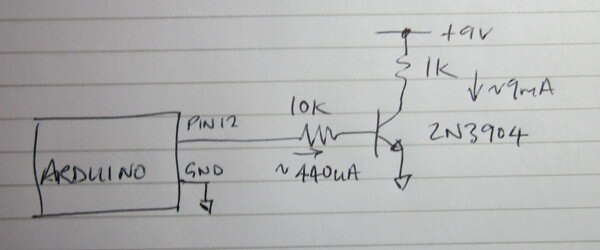
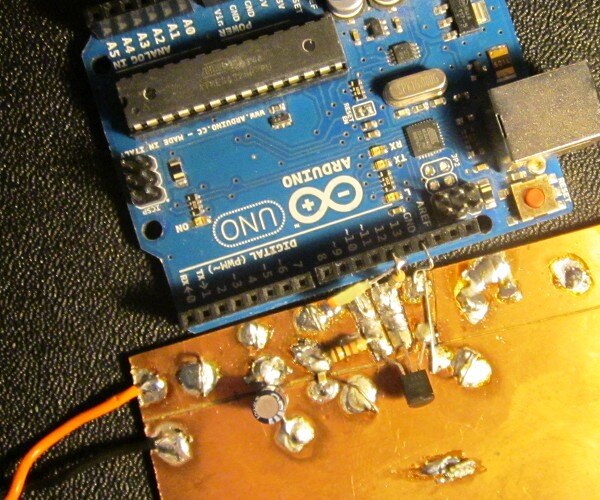
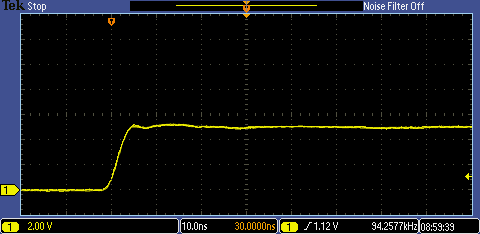
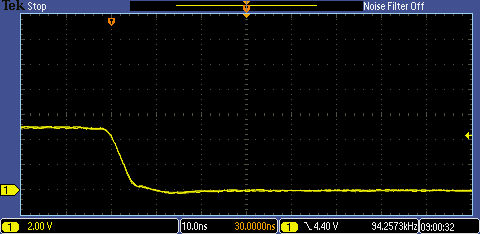
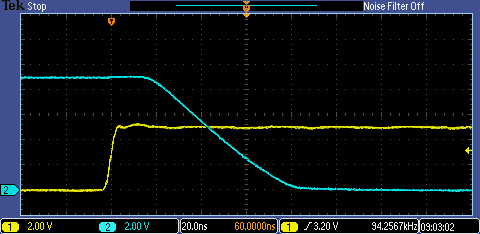
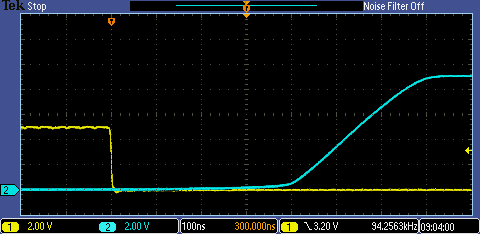
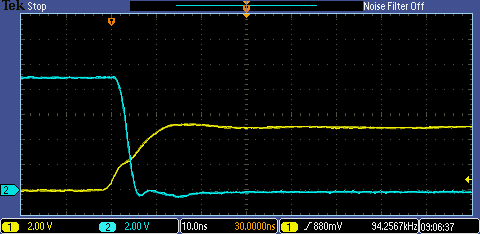
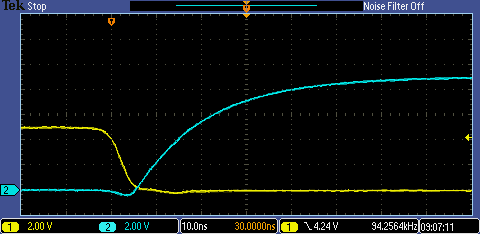
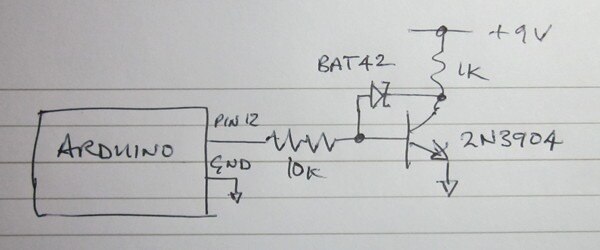
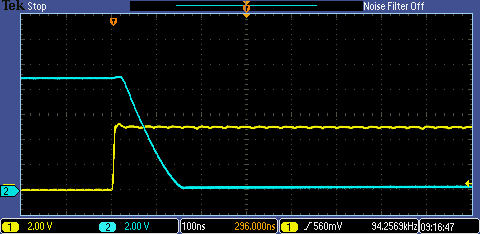
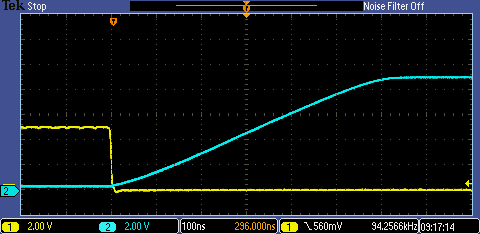
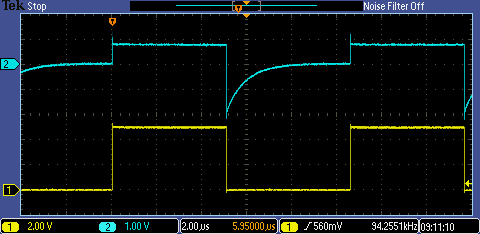
Top Comments
-

jc2048
-
Cancel
-
Vote Up
+6
Vote Down
-
-
Sign in to reply
-
More
-
Cancel
Comment-

jc2048
-
Cancel
-
Vote Up
+6
Vote Down
-
-
Sign in to reply
-
More
-
Cancel
Children